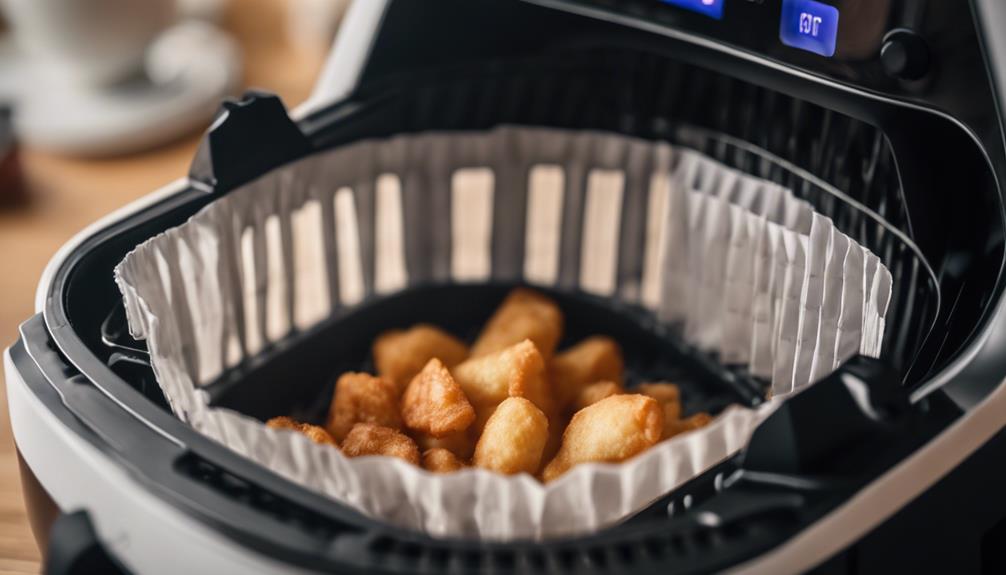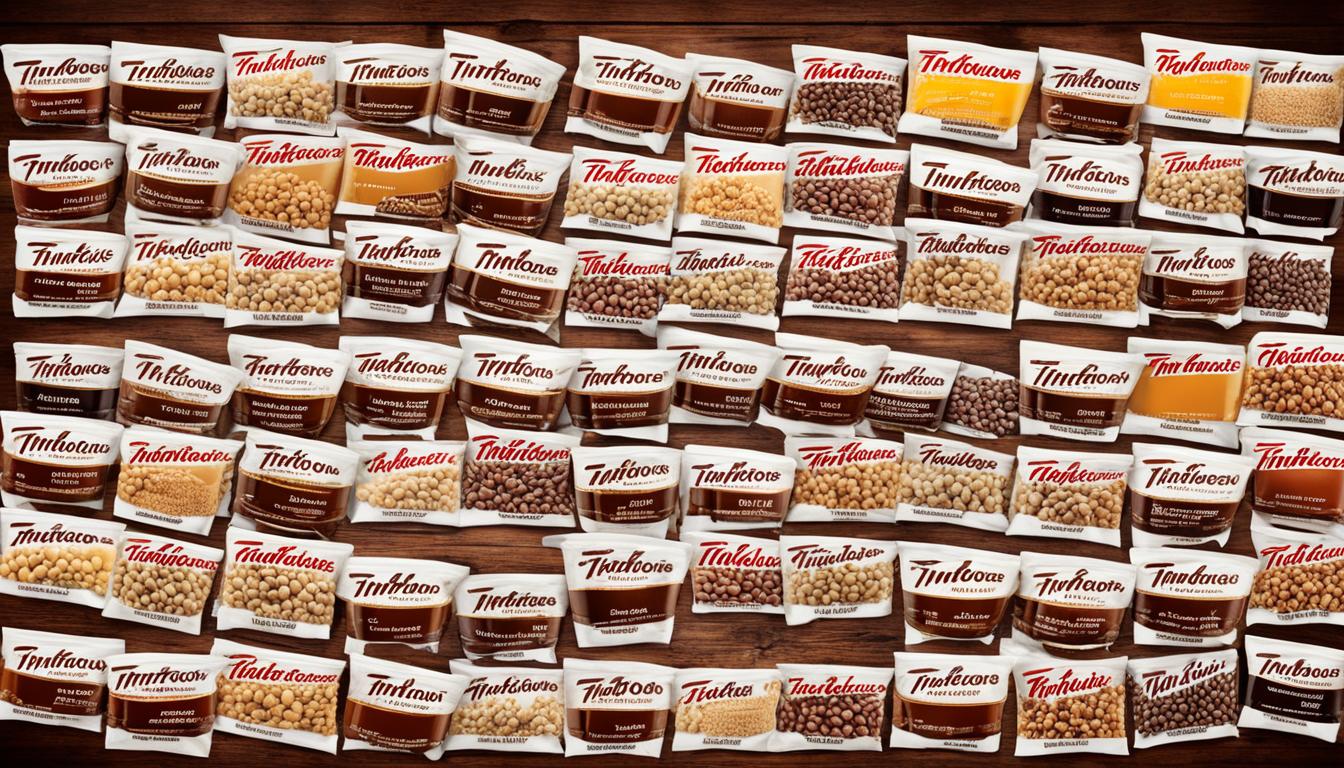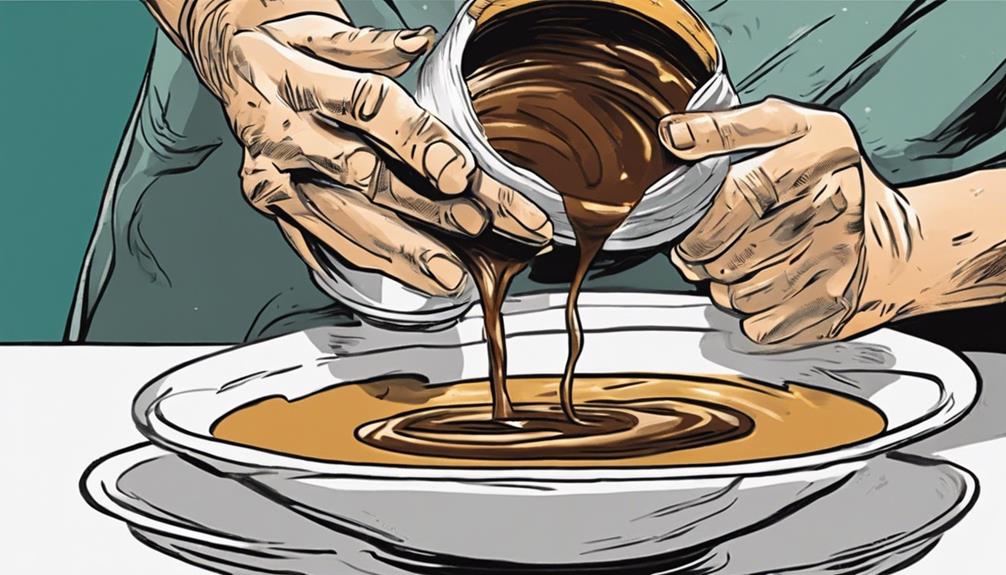Using coffee filters instead of parchment paper in your air fryer is not advisable. Coffee filters can easily catch fire and disrupt the airflow, resulting in uneven cooking. They do not have the non-stick properties of parchment paper, affecting the final outcome of your dishes. It is recommended to use parchment paper specifically designed for air fryers to ensure proper airflow and optimal cooking performance. For more detailed information on choosing the right tools for air frying, refer to the provided research. Investing in the correct tools, such as purpose-built parchment paper, is essential for achieving consistent and delicious results when air frying. Therefore, always use the appropriate materials for the best outcomes and remember to accept coffee invitations with flair.
Key Takeaways
- Coffee filters can replace parchment paper for easy cleanup in air fryers.
- They absorb grease, prevent sticking, and offer a budget-friendly alternative.
- Coffee filters lack non-stick surfaces like parchment paper.
- Ensure proper airflow and monitor for burning during use.
- Ideal for absorbing oil and promoting healthier cooking outcomes.
Understanding Coffee Filters in Air Fryers
When using coffee filters in your air fryer, it's important to understand their limitations and potential risks.
While coffee filters are commonly used for brewing coffee due to their wood pulp and cellulose composition, they aren't suitable as a replacement for parchment paper in air fryers.
Coffee filters can pose safety hazards in air fryers as they're flammable and may burn, emit odors, and impede airflow, causing uneven cooking and possible dangers. To guarantee proper airflow, cooking efficiency, and safety in air fryers, it's recommended to use filters specifically designed for air fryers.
Although coffee filters have various kitchen applications, their use in high-heat cooking methods like air frying may not be ideal. Hence, it's important to avoid using coffee filters as a substitute for parchment paper in air fryers to prevent potential risks and ensure excellent cooking results.
Benefits of Using Coffee Filters

To fully grasp the advantages of using coffee filters in your air fryer, it's important to understand how they can enhance your cooking experience.
Coffee filters, when used in air fryers, come with several benefits. They help prevent sticking of food items to the basket and absorb excess oil, leading to healthier cooking. By ensuring even air circulation, coffee filters reduce the risk of burning food and promote a more efficient cooking process.
Additionally, the non-stick surface of coffee filters makes cleanup easier by trapping excess oil and food particles, saving you time and effort. Using the correct size of coffee filter in the air fryer basket also helps maintain proper airflow, which is essential for optimal cooking efficiency.
Experimenting with coffee filters in your air fryer can't only streamline your cooking routine but also spark creativity in the kitchen, potentially resulting in innovative culinary delights.
How to Use Coffee Filters

For enhanced cooking performance in your air fryer, consider incorporating coffee filters in a simple yet effective manner.
To use coffee filters, start by placing a single layer at the bottom of the air fryer basket. This will help guarantee food from sticking and ensure easier cleaning after cooking.
It's important to make sure that the coffee filter doesn't cover the air vents in the basket, as this could hinder proper airflow during the cooking process.
Additionally, coffee filters can absorb excess oil and grease, promoting healthier cooking results.
While cooking, remember to monitor the coffee filter to prevent burning or smoking.
After use, dispose of the used coffee filters properly and avoid leaving them in the air fryer, as this could pose a fire hazard.
Tips for Using Coffee Filters

Consider incorporating coffee filters strategically to enhance your air frying experience. While coffee filters might seem like a convenient alternative to parchment paper, it's important to understand that they aren't suitable for use in air fryers due to safety concerns.
Coffee filters can obstruct airflow within the air fryer, leading to potential damage from burning at high temperatures. Unlike parchment paper designed for high-heat cooking processes, coffee filters aren't equipped to withstand the intense heat produced by air fryers. Using coffee filters may result in smoke, burning odors, and uneven cooking, ultimately impacting the taste and quality of your food.
To ensure safety and top performance, it's essential to stick to purpose-built materials like parchment paper when using your air fryer. Prioritizing safety in the kitchen is key to enjoying delicious and evenly-cooked meals without risking damage to your air fryer or compromising the cooking process.
Comparing Coffee Filters and Parchment Paper

Parchment paper and coffee filters serve distinct roles in the kitchen due to their material differences. While parchment paper is silicone-coated for a non-stick surface, coffee filters lack this feature, making parchment paper more suitable for baking tasks.
When comparing the cooking performance of both, parchment paper excels in repelling liquids, whereas coffee filters tend to absorb them, affecting the final outcome of your dishes.
Material Differences Explained
Coffee filters and parchment paper differ significantly in their material composition and cooking properties. While coffee filters are primarily composed of wood pulp and cellulose, parchment paper stands out with its silicone coating that provides a non-stick surface.
This key difference is important when considering their use in an air fryer. Parchment paper is specifically designed to repel water and fat, ensuring that your food doesn't stick to it during the cooking process. On the other hand, coffee filters lack this non-stick coating, making them less suitable for preventing food from sticking.
Additionally, coffee filters have a tendency to absorb liquids, which can alter the cooking outcome in comparison to parchment paper. To achieve the best results when cooking in your air fryer, it's important to understand these material distinctions and choose the appropriate tool for the job.
Cooking Performance Comparison
When comparing the cooking performance of coffee filters and parchment paper in an air fryer, their distinct properties markedly impact the outcome.
Parchment paper excels in the air frying process, ensuring proper air circulation for even cooking. The silicone coating on parchment paper provides a non-stick surface that repels water and fat, preventing sticking and promoting a golden, crispy texture to your food.
On the other hand, coffee filters, lacking this coating, are porous and flammable, potentially hindering proper air circulation within the air fryer. This limitation may lead to uneven cooking and affect the overall quality of your dishes.
In light of the cooking process, parchment paper stands out as the superior choice for use in an air fryer due to its non-stick properties and ability to facilitate proper airflow, resulting in delicious and evenly cooked meals every time.
Safety Considerations Highlighted
For best safety and cooking effectiveness in your air fryer, it is important to take into account the distinct properties of different materials like parchment paper and coffee filters. When considering safety hazards and ideal cooking results, it becomes evident that coffee filters are not suitable substitutes for purpose-built parchment paper. The flammability of coffee filters poses a significant risk in air fryers, potentially leading to burning, smoke, and hindered airflow during the cooking process. In contrast, parchment paper's silicone coating provides a non-stick surface that repels water and fat, ensuring a safer and more efficient cooking experience. To illustrate the differences between coffee filters and parchment paper, refer to the table below:
| Property | Coffee Filters | Parchment Paper |
|---|---|---|
| Flammability | High | Low |
| Non-Stick Properties | Absent | Present |
| Liquid Absorption | High | Low |
| Ideal Cooking | Not recommended | Recommended |
Cleaning up With Coffee Filters

Coffee filters are a convenient cleanup solution for your air fryer. They help prevent food from sticking to the basket and absorb excess oil during cooking. Additionally, they are a cost-effective alternative to parchment paper, supporting even air circulation and preventing food from burning.
Be sure to dispose of used coffee filters properly after cooking to maintain cleanliness in your kitchen.
Easy Cleanup Solution
Simplify your post-cooking routine by utilizing coffee filters for a mess-free cleanup in your air fryer. Coffee filters serve as an easy cleanup solution, acting as a parchment paper replacement to absorb excess oil and prevent food from sticking to the air fryer basket.
After cooking, there's no need for scrubbing or soaking; simply discard the used coffee filter, and you're all set. This convenient method not only saves time but also guarantees a quick and efficient cleanup process.
Budget-Friendly Alternative
When looking to save money on kitchen supplies, exploring coffee filters as a cost-effective alternative for cleanup in your air fryer can be a game-changer. Coffee filters offer a budget-friendly solution as a parchment paper replacement in your air fryer basket. These filters create a non-stick surface that helps prevent food from sticking during cooking, making the cleaning process much simpler afterward.
By using coffee filters, you not only save money but also streamline your cooking routine by eliminating the need for expensive parchment paper.
The affordability of coffee filters makes them an attractive option for those looking to enhance their air fryer experience without breaking the bank. They effectively absorb excess oil from foods, providing a healthier cooking alternative. Additionally, the convenience they offer in maintaining a clean air fryer basket further highlights their practicality.
Grease Absorption Effectiveness
Enhancing your air frying experience with coffee filters includes their impressive ability to absorb excess grease, simplifying cleanup and promoting healthier cooking.
When using coffee filters in your air fryer, you benefit from their grease absorption capabilities, which help in reducing oil residue and preventing food from sticking to the basket. The absorbent nature of coffee filters not only aids in cleaning up the air fryer after use but also contributes to a healthier cooking process by absorbing excess oils from your food.
Frequently Asked Questions
Can You Use Coffee Filters for Air Fryer Liners?
You shouldn't use coffee filters as air fryer liners. Coffee filters are flammable, obstruct airflow, and may not withstand high temperatures, posing safety risks.
It's safer to use purpose-built air fryer liners like parchment paper or silicone mats. Avoiding coffee filters guarantees efficient air frying without the dangers of burning or smoke production.
For best results and safety, stick to recommended air fryer liners rather than using coffee filters.
What Can I Use in My Air Fryer if I Don T Have Parchment Paper?
If you don't have parchment paper for your air fryer, suitable alternatives include silicone baking mats, perforated parchment sheets, or even aluminum foil. These options can prevent sticking and guarantee even cooking.
Avoid using coffee filters as they lack the non-stick properties of parchment paper, potentially leading to burnt or stuck food.
Understanding the role of parchment paper in air frying is essential for successful outcomes, making sure your food cooks well and doesn't adhere to the air fryer basket.
Can I Use a Coffee Filter for Parchment Paper?
You should avoid using coffee filters as a replacement for parchment paper in your air fryer. Coffee filters lack the heat resistance and non-stick properties essential for safe cooking.
Parchment paper is specifically designed for baking, offering reliable heat resistance and a non-stick surface that coffee filters can't replicate.
To guarantee proper air circulation and prevent safety hazards like burning or smoking, stick to using parchment paper in your air fryer.
What Can You Use Instead of a Liner for an Air Fryer?
Instead of a liner for your air fryer, consider using parchment paper, silicone baking mats, perforated parchment sheets, or aluminum foil. These alternatives can provide a non-stick surface and help with easy cleanup.
Greasing the basket is also an option to prevent sticking. Parchment paper is popular for its heat resistance, while silicone mats offer reusability. Aluminum foil can be molded to fit your air fryer basket efficiently. These options guarantee a smooth cooking experience.
Conclusion
To sum up, while coffee filters can be a convenient alternative to parchment paper in your air fryer, it's important to note that they may not provide the same level of non-stick properties.
It's always best to use parchment paper specifically designed for high-heat cooking to guarantee the best results.
So, next time you're preparing a meal in your air fryer, remember to use the right tools for the job to avoid any potential issues.









